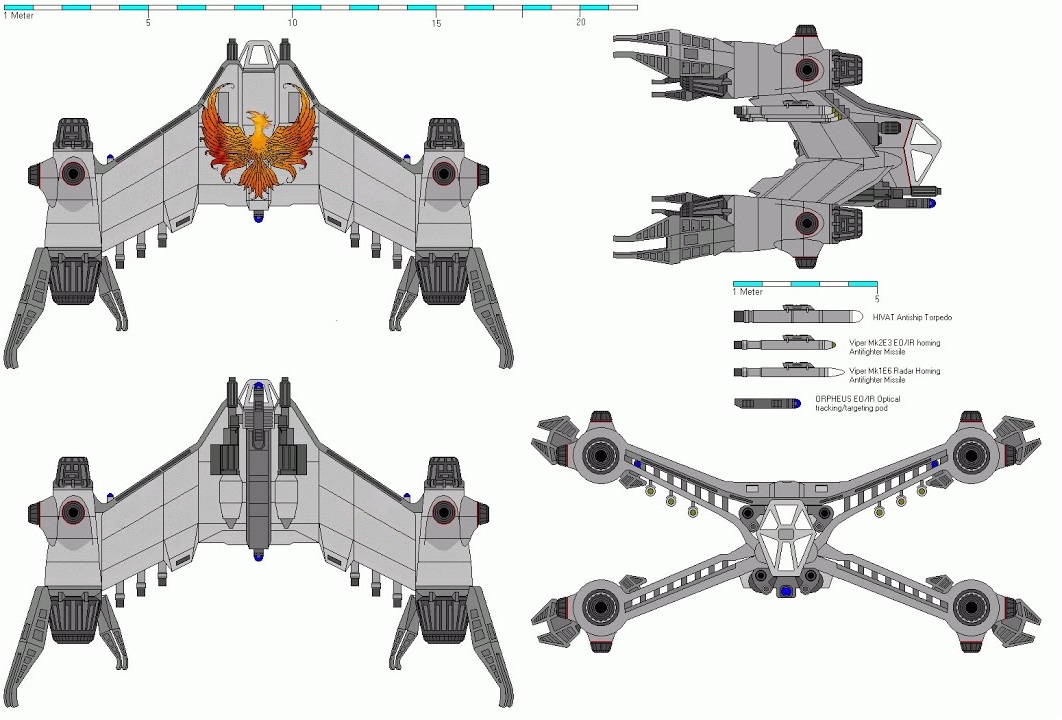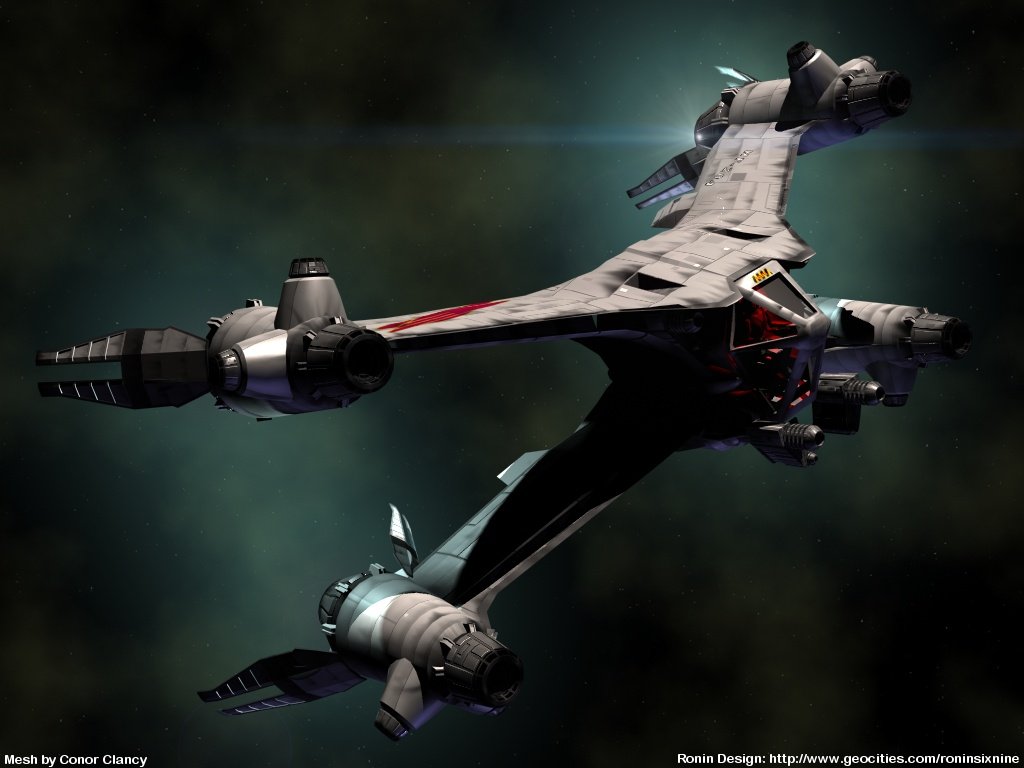
United Galaxies Council. | SA-23 Mitchell-Hyundyne
Starfury. | 
United Galaxies Council. |
|---|
SA-23 Mitchell-
Hyundyne Starfury: |
|---|
 |
|---|
| Production Information: |
|---|
| Manufacturer: | UGC. |
|---|
| Type: | Deep Space Fighter. |
|---|
| Technical Specifications: |
|---|
| Length: | 31 feet 4 inches. |
|---|
| Mass: | 48 tons. |
|---|
| Armament: | Quad 40MM pulse cannons;Twin 30MM pulse cannons (rear);A grapple claw and cutting laser. |
|---|
| Crew: | 1. |
|---|
| Engines: | Quad Beigle-Bryant 9000A Particle Thrust Engines. |
|---|
| Power: | 3 fusion batteries. |
|---|
| Usage: |
|---|
| Status: | Active. |
|---|
| Afilliation: | Babylon-Class Star Stations. |
|---|

A standard Starfury Deep Space Fighter. |
|---|
The SA-23 Mitchell-Hyundyne Starfury is the Babylon-Class Star Stations standard fighter craft. These fighter were in fact specifically developed for the Babylon-Class Star Stations as part of a political desision; Since every Babylon-Class Star Station is built including a Starfury factory, and ONLY Babylon-Class Star Stations are built with these factories, allowing them to be independant of all militry powers other than themselves.Technical SpecificationsArmamentA Starfury carries four forward-firing JC 266 20-megawatt pulse discharge cannons and two rear-firing 30mm plasma pulse discharge cannons. The cannons are controlled by a Duffy 1018 MJS smart targeting computer with a maximum scope of 70,000 km. A grappling hook is housed in the ventral hull.ManuverabilityStarfuries are highly maneuverable with the ability to spin 180 degrees on under a second. This combined with the heavy weapon load make them one of the most impressive younger race fighter craft able to fight to a standstill all other younger race fighters, excluding the Minbari's.CockpitAn unusual feature of these fighters is that the pilot does not sit in the cockpit but stands in an upright position and operates the fighter with a combination of hand, feet and voice controls. This position also allows maximum visual scope and maximum blood flow reducing the risk of blackouts from sharp maneuvers. The craft are outfitted with a cockpit ejection system.HistoryWhen the Babylon-Class Star Stations were first proposed, it was realized that they would need protection from enemy combatants, ranging from the utterly inept to the highly sophisticated. Some, inevitably, would include space fighters/attackers and shuttles, which are difficult for ship-mounted batteries to deal with.Obviously, a fighter would be required; However, to include an existing fighter design to the Babylon-Class' inventory risked the danger of making the creators of that design in some way 'superior' to others. Therefore, the UGC decided to develop a wholly new design, which would only be possible for theWith the UGC's blessing, and assistance from the REF, various RDF's, the Brotherhood of Steel (and, by implication, the GIB, and more specifically Mithril), the Starfury Project began to develop a fighter that could be built by the stations (meaning, in turn, that the factories themselves had to be very compact and efficient), able to take on within reason any other UGC or allied fighter (less the Veritech Fighter, since those are still the best of the best), and was totally NEW. Any prior design could be drawn upon for inspiration (all UGC RDF's are required to submit full blueprints for all militry platforms as part of their application for membership), but no specific design could supply more than 05% total inspiration to the final design.The final design, submitted by the Mitchell-Hyundyne Corporation of Wayside (a UGC colony world, and therefore a surprising entrant, let alone winner) was the best of the designs submitted, but is sadly underwhelming; Though it is an excellent concept, the design was underpowered. Each Babylon-Class Star Station was given authorization to solve their fighter's issues at their own discretion- This means that no two station's produce the exact same fighter, though the characteristics are generally the same (not much beyond 01% difference). It is a curious detail that Mitchell-Hyundyne itself did make a point of this detail; They never hid the issue with their design. Conspiracy theorists allege that the fighter were selected fro exactly that reason, and in this caser they're right; The UGC selected the slightly inferior, in that detail, SA-23 to encourage each station to develop their own fighters, making them just that little bit more technically independent.Name:Starfury Fighter.Type: Deep space fighter.Crew: 1.MDC By Location: |
Hull-
Bridge-
Hatches (6)-
Access Tube- | 1,000
800
250 each
750 | Var. Force Fields (6)--
Engine Compartment-
Thrusters (4)-
Weapons Pods (variable)- | 800 each
800
600 each
250 each |
| Notes: Usual penalties apply. |
| Speed and Statistical Data: |
Speed: 800 mph.
Maximum Range: 500 miles from a Babylon-Class Star Station.
Flight Distance: 50,000 miles, but can not go further than 500 miles from their ship.
Clearance: 25 feet.
Wingspan: 40 feet.
Length: 31 feet 4 inches.
Weight: 200 tons.
Cargo Capacity: 115,000 tons.
Power System: Several hundred nuclear generators and solar panels. | Drive System: Quad Beigle-Bryant 9000A Particle Thrust Engines.
Flight Pattern: With the exception of Babylon FIVE, all Babylon- Class Star Stations enter the assigned system and takes a permanent station at the main system entry point, usually out near the system's further planetoid.
Cost and Availability: Each fighter costs 10 millioncredits takes 20 days to build (as many as 500 are being built at any given time).
Black Market Cost and Availability: Just don't bother. A master black marketer will laugh at you- If he doesn't shoot you as a suspected cop.
|
| Weapon Systems: |
|---|
1. Quad Forward Laser Cannons: An anti-fighter/missile weapon.
Purpose: Anti-Aircraft
MD Per Cannon: 3D6.
Rate of Fire: Equal to the pilots total number of attacks per melee.
Range: 12 miles.
Payload: Effectively unlimited.
2. Variable Full-Force Barrier Field: The Variable Full-Force Barrier Field provides additional protection for the vessel.
Purpose: Defense.
MDC: 800 per panel; 1,600 total available. NOTE: Each panel MUST still have 1 MDC for the system to continue working.
Effect: Provides 800 MDC in each of 06 panels.
Range: 40 feet.
Coverage Characteristics: A full 360º coverage area around the ship.
3. Retractable Grappling Claw: Housed in the ventral hull for towing with a corresponding hitch-point located on the ventral aft tail.
Purpose: Defense.
Effect: Reaches out and grabs a given target. Does not normally do damage (if the target is already damaged, it "may" do 1D4 additional MD).
Range: 4,000 feet.
Coverage Characteristics: A full 360 degree coverage area around the ship, but typically used aft.
| 4. Wing Hardpoints: Eight under wing hardpoints per wing can also carry a variety of weapons loads. However, each hardpoint reduces the stealth of the craft 05% (a total of 20% when all 4 are used).
A) PBC-7 Particle Beam Cannon: Adapted directly from the T'sentraedi Battle Pod PBC.
Range: Varies with missile types, mini-missiles only.
Mega Damage: Varies with mini-missile types.
Rate of Fire: Each pod can fire one at a time or in volleys of 2, 4, 8, or 16 and can be linked with other mini missile pods for greater number of missiles (Counts as one attack no matter how many missiles in volley).
Payload: Each pod carries 16 mini-missile.
B) External Bomb Load: An external bomb load is available to drop any combination of light or medium bombs.
Maximum Effective Range: Varies by altitude bombs are dropped at.
Mega Damage: Varies by bomb type.
Rate of Fire: One big volley of everything you've got.
Payload: 3 heavy, 6 medium, or 16 light bombs
C) Mini-Missile Pod: Large capacity mini-missile pod. These pods are not carried on the body of the Mecha but are only carried on the wings. The Mecha normally carries missile pods for anti-personnel attacks and anti-missile defense. Normal missiles used are armor piercing, high explosive, or fragmentation mini-missiles.
Maximum Range: Varies with missile types.
Mega Damage: Varies with mini-missile types.
Rate of Fire: Each pod can fire one at a time or in volleys of 1, 2, 4, 6, 8, 12, or all 18 and can be linked with other weapons systems for greater accuracy and power to target (counts as one attack no matter how many missiles in volley).
Payload: Each pod carries 18 mini-missile.
D) Short Range Missile Pod: The most commonly requested armament, these missile are generally used as anti-aircraft defense. The AG-28 is, just simply put, a dogfighter. Also used to destroy helicopters and other aircraft In the air.
Maximum Range: Varies with missile types.
Mega Damage: Varies with missile type.
Rate of Fire: Each pod can fire one at a time or in volleys of 1, 2, 4, 6, or 8 and can be linked with other weapons systems for greater accuracy and power to target (counts as one attack no matter how many missiles in volley).
Payload: Each pod carries 8 short range missiles.
E) Medium Range Missile Pod: Normally used for anti-armor/anti-aircraft.
Maximum Range: Varies with missile types.
Mega Damage: Varies with mini-missile types.
Rate of Fire: Each pod can fire one at a time or in volleys of 2 or 3 and can be linked with other weapons systems for greater accuracy and power to target (counts as one attack no matter how many missiles in volley).
Payload: Each pod carries 3 medium range missile.
F) Long Range Missile Pod: Large capacity mini-missile pod. These pods are not carried on the body of the Mecha but are only carried on the wings. The Mecha normally carries missile pods for ground strafing, anti-troop, and anti-emplacement attacks. Normal missile used are armor piercing, plasma, or fragmentation mini-missiles.
Maximum Range: Varies with missile types, mini-missiles only. Mega Damage: Varies with mini-missile types.
Rate of Fire: Each pod can fire one at a time or in volleys of 2, 4, 8, or 16 and can be linked with other mini missile pods for greater number of missiles (Counts as one attack no matter how many missiles in volley)
Payload: Each pod carries 16 mini-missile. |
| Features: |
- Video Recorder: Records from sensors and the cockpit itself. 500 hours of recording available.
- Radar: Civilian grade radar. Range: 20,000 miles, can track up to 250+/- individual targets. 95% reliability (00% against stealthed vehicles).
- FLIR/SLIR: Forward and Side Looking Infrared. Allows pilot and weapons officer to get visuals on targets at night.
- ESM: Radar Detector. Passively detects other radars being operated.
- Decoy Pods: The Steneirian style decoy pods were installed on the ships for self-defense. The decoys themselves are specially modified Mini-Missiles that produce burning globs of magnesium/aluminum alloy to confuse both radar AND heat sensory systems, obscuring the ship. NOTE: Reduce effects by 20% against smart missiles (add +20% to rolls for smart missiles.)
- Effect:
- 01-50: Enemy missile or missile volley detonates in chaff cloud - Missiles are all destroyed.
- 51-75: Enemy missile or missile volley loses track of real target and veers away in wrong direction (may lock onto another target).
- 76-00: No effect, missile is still on target.
- Also note that the chaff cloud will also blind nearby heat sensors (and optically based sensors at night) for 1 melee. They will suffer the following penalties: Reduce melee attacks/actions, and combat bonuses by half. Also, a cloud of smoke approximately 253 feet.
- Duration: 1D4 melee rounds.
- Rate of Fire: Once per melee.
- Payload: 6 chaff/flares.
| - AJP: Active Jamming Pod. Causes -25% to detection but when it is active, other vehicles/bases can detect that it is jamming, and some missiles will home in on jamming signals. Jamming also causes a -4 penalty to all radar guided weapons.
- Full Range Sensory Suite: Infrared, ultra violet, Magnification, night sight, color filters, thermal imager. Range is about 2,000 miles for MOST sensors.
- Motion Detector: Activates a loud wailing when an object is coming at the user fast, and a soft ringing if it's coming slowly. Activation ranges must be specified by the pilot.
- Anti-Jamming System: Reduces Electronics Countermeasure by 75% (decrease skill level appropriately).
- Electronic Counter Measures (ECM): These systems disrupt enemy radar and tracking systems, making it difficult for them to lock onto the ship with weapons. The countermeasures give the Mecha a +3 to dodge, +2 to strike and +1 on initiative in combat.
- Fire resistance: Fires external to the craft have no effect on it.
- MRA 6 Radios: Allows real time, continuous radio link up with friendly forces in the area via satellite relay over laser radio signals, preventing jamming, and automatically encrypts/decrypts same to prevent eavesdropping.
- Type-11 wide band radios: Effective 10 mile range, auto encrypt/decrypt. Works on standard radio band wavelengths, so it can still be jammed (if the enemy knows the frequencies).
- HoloNet Hyperradio Rectenna :Gives the ship instantaneous links to HoloNet transceivers and can cataloged many thousands of transmissions from across the galaxy.
Purpose: Communications
System Type: Radio
Effect: Carries video signals.
Range: Intra-galactic.
|
Combat Bonuses From Academy-Class Combat Elite: Technically none; However, individual skippers are known to extensively modify their ships to improve performance.- Up to 3 additional attacks per melee.
- Up to +4 Parry, Dodge, and Roll.
- Up to +2 Strike.
Even these bonuses can be improved, but will require far more modification. |



